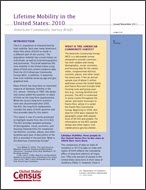Lifetime Mobility in the United States: 2010
Lifetime Mobility in the United States: 2010
Introduction
The U.S. population is characterized by high mobility. Each year many Americans leave their place of birth to reside in a different part of the country.1 The population mobility has crucial impact on individuals, as well as local demographics and economies. This brief examines lifetime mobility in the United States using place of birth and current residence data from the 2010 American Community Survey (ACS). In addition, it examines how such mobility varies by age and geographical area.
Place of birth has long been an important measure of domestic mobility in the U.S. census.2 Starting in 1960, the decennial census asked the question on place of birth on the long-form questionnaire. While the census long-form questionnaire was discontinued after 2000, the ACS, the long-form replacement, includes the place of birth question and thus provides data for this report.
This report is one of a series produced to highlight results from the 2010 ACS. The ACS provides detailed estimates of demographic, social, economic, and housing characteristics for congressional districts, counties, places, and other localities each year. A description of the ACS is provided in the text box “What Is the American Community Survey?”
__________
1 Frey, William H. (2009). “The Great American Migration Slowdown: Regional and Metropolitan Dimensions.” Brookings Policy Brief. Washington, DC: Brookings Institute.
2 Long, Larry E. (1988). Migration and Residential Mobility in the United States. Population of the United States in the 1980s: Census Monograph Series. New York: Russell Sage Foundation.
Others in Series
Publication
Publication
Publication




